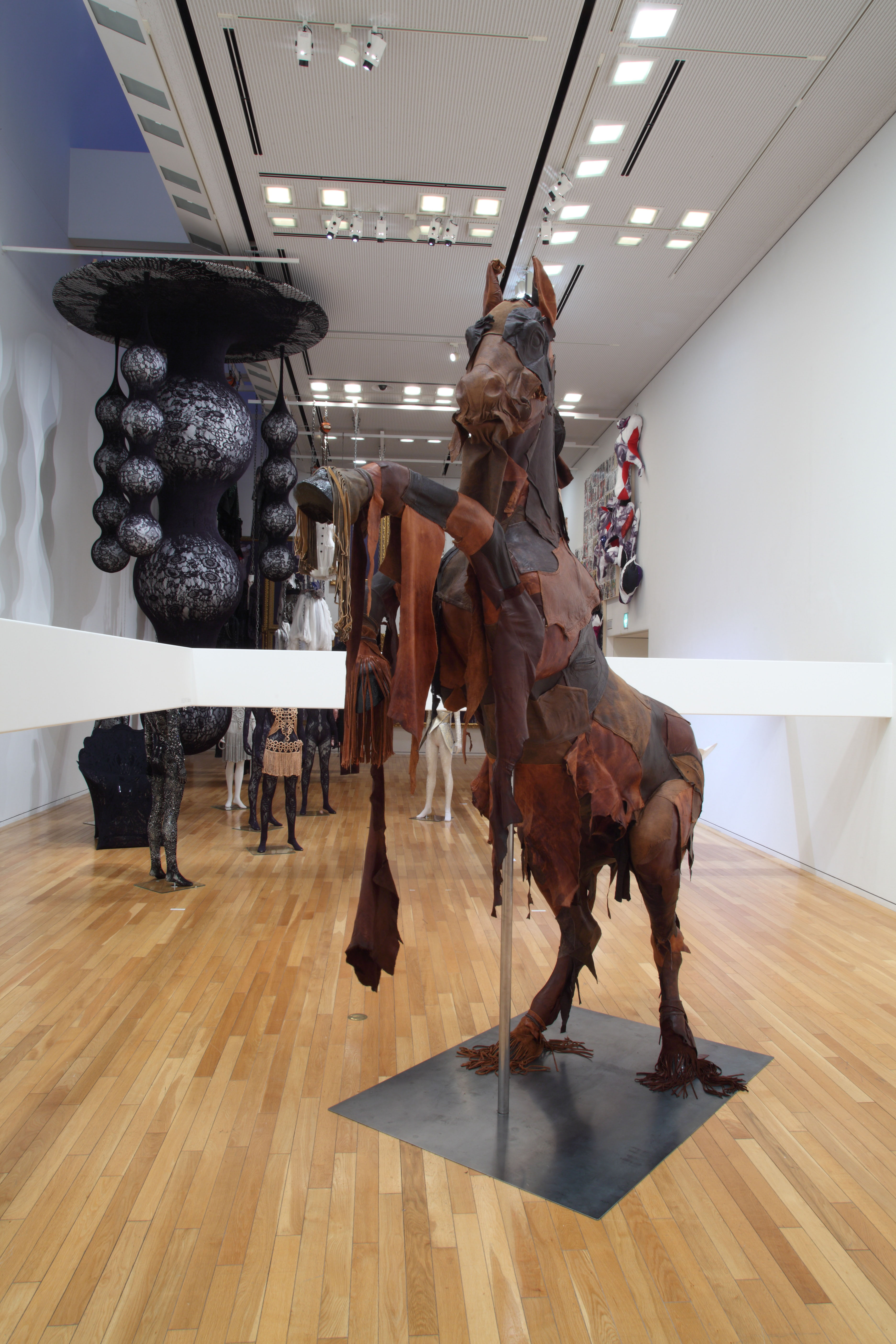A life-size bucking brown horse, pieced together from old leather jackets. A loom operated by a Noah's Ark collection of polar bears, birds and other beasts. A fashion boutique till that scans barcodes to create a cacophony of musical sounds.
Hearing the words "fashion" and "exhibition" in the same sentence often conjures images of mannequins as sedate as they are static, displayed conventionally with museum-like reverence.
That, however, could not be further from the truth at Tokyo Opera City Art Gallery's latest exhibition, for which 10 modern Tokyo-based fashion designers were asked one seemingly simple question: "What is fashion?"
Their answers — as manifested in an array of imaginatively creative and surprising forms — are now on display in "Feel and Think: A New Era of Tokyo Fashion."
Upon entering the gallery, the first impact is the layout design: There is no hint of the world of fashion. Instead, the space is abstractly segmented with a network of white joists that, hovering at eye level, serve to "separate and connect," in the words of the architect-creator Ryuji Nakamura.
The end result is a sense of division yet harmony between the spaces comprising the entire exhibition area, where 31 joists take the place of walls, loosely creating 20 segments.
A side effect is a readjusted sense of personal space, with other visitors often appearing headless in the distance. Another is a heightened self-awareness, which is required to avoid banging your head as you stoop beneath the beams.
One of the first things that shifts into focus among the white partitions is the ominous black silhouette of a bull. Created by the menswear designers SASQUATCHfabrix, the beast — like the rearing horse encountered further on — is made from deconstructed second-hand leather jackets that were most likely once coveted before being discarded — a dark symbol of the 21st century's disposable fast fashion.
Then, in between ducking under the joists, there is another sight that requires a moment of visual adjustment: It looks like a fashion boutique interior, but everything has been stretched so that it is super tall and skinny, from the hanging clothes and red high-heeled shoes to the till on the counter.
Just around the corner is the same shop interior, but this time everything is wide and short, right down to the catalog brochure on the counter, which contains photos of short, wide models strutting and pouting.
The distorted space, created by Anrealage, inspired by the theme "question the standard," visually probes the controversial terrain of what is acceptable and what is not among traditionally dogmatic fashion standards.
Interaction beckons a few joists along with Mina Perhonen's display, where two intricate, colorful installations allow visitors to place their head through a funfair-style cut-out and see themselves transformed in the mirror before them.
Other segments range from the otherworldly mannequin creatures of Somarta, resembling futuristic warriors in their seamless lace full-body stockings to h. Naoto's subculture figures eerily suspended by chains from the ceiling and representing the more extreme Goth-Lolita end of the Harajuku fashion spectrum.
Amid the abstract questioning and visual surprises, there occasionally pop up moments of pure fashion appreciation — as in the case of mintdesigns.
Their "TRASH, SLASH and FLASH" installation of colorfully stylish dresses stacked on reams of equally vibrant shredded paper may unleash a flow of inner questioning about the value of rubbish — or, as in my case, may simply make you instantly want to buy one of their pieces and take it home.
And then — there is the dramatically conceptual as in the case of Writtenafterwards. Visitors peer through the windows of a hut and discover a giant, clanking weaving machine, being operated by a fantastical selection of stuffed lions, owls, squirrels, ducks and more.
The creatures work collectively to produce not clothes but bank notes, which are in fact "zero yen bills," while in a further twist, the whole operation is being overseen by a naked man, complete with a neon halo and a serpent around his ankle, who watches through a small window.
It's a thought-provoking installation that bears little resemblance to conventional fashion displays but clearly taps into the creative conscience of many new-generation Tokyo designers — a conscience unsettled by insatiable consumerism and the rise of fast fashion in all its disposable glory.
Perhaps the liveliest moment of the show comes at the end. A shop floor, complete with bar-code scanners, which when swiped across the tags of clothes and accessories on display, produce instrumental sounds and images projected onto a white wall.
As visitors laughingly bleep different items and a clashing symphony of sounds and musical noise fills the air, it taps into what, at the end of the day, remains of underlying importance for almost any creative fashion designer — a sense of fun.
"Feel and Think: A New Era of Tokyo Fashion" at Tokyo Opera City Art Gallery runs till Dec. 25; admission ¥1,000, closed Mon. For more information, visit www.operacity.jp.

















With your current subscription plan you can comment on stories. However, before writing your first comment, please create a display name in the Profile section of your subscriber account page.